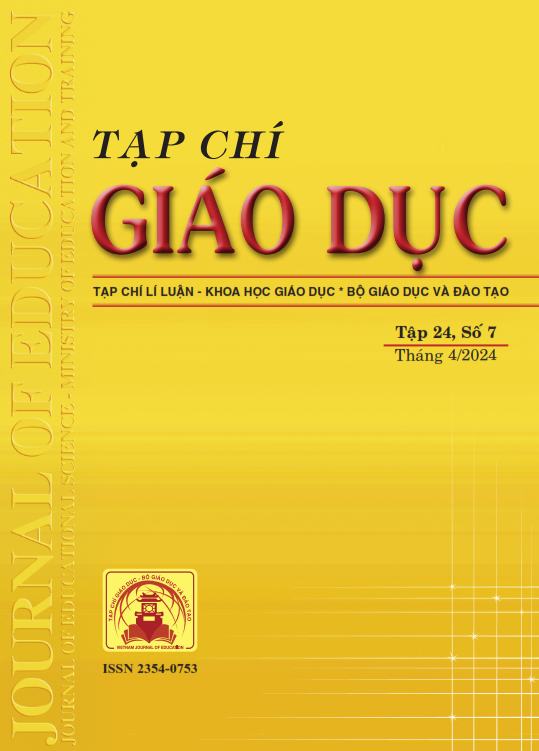Tổ chức dạy học phần “Cấu tạo nguyên tử” (Hóa học 10) theo mô hình Lớp học đảo ngược nhằm phát triển năng lực nhận thức hóa học cho học sinh
Tóm tắt
Chemical cognitive competence is one of the specialized chemistry competences of high school students. This article examines the development of students’ chemical cognitive competence through organizing the teaching of the module “Atomic Structure” with the Flipped Classroom model at high schools in Ninh Binh Province. The students learnt new knowledge at home through e-learning and then exchanged opinions with teachers in class. After two lessons taught according to the Flipped Classroom model, chemical cognitive competence was initially developed. The students’ learning outcomes were improved, and the expressions of chemical cognitive competence at low cognitive levels developed faster than those at high cognitive levels. Therefore, to fully develop chemical cognitive competence, it is necessary to take impact measures over a sufficient period of time.
Tài liệu tham khảo
Anderson, J. R. (1982). Acquisition of cognitive skill. Psychological Review, 89(4), 369.
Anderson, J. R. (1991). Is human cognition adaptive?. Behavioral and Brain Sciences, 14(3), 471-485.
Bhagat, K. K., Chang, C. N., & Chang, C. Y. (2016). The impact of the flipped classroom on mathematics concept learning in high school. Educational Technology & Society, 19(3), 134-142.
Bộ GD-ĐT (2018a). Chương trình giáo dục phổ thông - Chương trình tổng thể (ban hành kèm theo Thông tư số 32/2018/TT-BGDĐT, ngày 26/12/2018 của Bộ trưởng Bộ GD-ĐT).
Bộ GD-ĐT (2018b). Chương trình giáo dục phổ thông môn Hóa học (ban hành kèm theo Thông tư số 32/2018/TT-BGDĐT, ngày 26/12/2018 của Bộ trưởng Bộ GD-ĐT).
Bergmann, J., & Sams, A. (2012). Flip your classroom: Reach every student in every class every day. International Society for Technology in Education.
Brame, C. (2013). Flipping the classroom. Vanderbilt University Center for Teaching. http://cft.vanderbilt.edu/ guides-sub-pages/flipping-the-classroom/
Chen, Y., Wang, Y., & Chen, N. S. (2014). Is FLIP enough? Or should we use the FLIPPED model instead?. Computers & Education, 79, 16-27.
Clark, K. R. (2015). The effects of the flipped model of instruction on student engagement and performance in the secondary mathematics classroom. Journal of Educators Online, 12(1), 91-115.
DeSantis, J., Van Curen, R., Putsch, J., & Metzger, J. (2015). Do students learn more from a flip? An exploration of the efficacy of flipped and traditional lessons. Journal of Interactive Learning Research, 26(1), 39-63.
Fautch, J. M. (2015). The flipped classroom for teaching organic chemistry in small classes: Is it effective?. Chemistry Education Research and Practice, 16(1), 179-186.
Gomez-Lanier, L. (2018). Building collaboration in the flipped classroom: A case study. International Journal for the Scholarship of Teaching and Learning, 12(2), 7-15.
Gundlach, E., Richards, K. A. R., Nelson, D., & Levesque-Bristol, C. (2015). A comparison of student attitudes, statistical reasoning, performance, and perceptions for web-augmented traditional, fully online, and flipped sections of a statistical literacy class. Journal of Statistics Education, 23(1), 1-33.
Karabulut‐Ilgu, A., Jaramillo Cherrez, N., & Jahren, C. T. (2018). A systematic review of research on the flipped learning method in engineering education. British Journal of Educational Technology, 49(3), 398-411.
Lage, M. J., Platt, G. J., & Treglia, M. (2000). Inverting the classroom: A gateway to creating an inclusive learning environment. The Journal of Economic Education, 31(1), 30-43.
Love, B., Hodge, A., Corritore, C., & Ernst, D. C. (2015). Inquiry-based learning and the flipped classroom model. Primus, 25(8), 745-762.
Nguyễn Hoàng Trang, Bùi Thị Thơm (2023). Tổ chức dạy học chủ đề “Liên kết hóa học” (Hóa học 10) theo mô hình “Lớp học đảo ngược” nhằm phát triển năng lực tự học cho học sinh. Tạp chí Giáo dục, 23(7), 19-23.
Nguyễn Hoàng Trang, Trần Thị Huế (2023). Tổ chức dạy học dự án chuyên đề “Hóa học và công nghệ thông tin” (Hóa học 10) nhằm phát triển năng lực giao tiếp và hợp tác cho học sinh. Tạp chí Giáo dục, 23(21), 12-17.
Nguyễn Kim Chi, Đặng Thị Thuận An, Lê Trần Diệu My, Nguyễn Thị Lan Anh, Dương Thị Tuyết Nữ (2023). Vận dụng mô hình 5E trong dạy học chủ đề “Nguyên tố nhóm VIIA” (Hóa học 10) nhằm phát triển năng lực nhận thức hóa học cho học sinh trung học phổ thông. Tạp chí Giáo dục, 23(số đặc biệt 7), 76-82.
Nguyễn Văn Đại (2022). Vận dụng mô hình lớp học đảo ngược trong dạy học phần Hóa học hữu cơ lớp 11 nhằm phát triển năng lực tự học cho học sinh. Tạp chí Khoa học, Trường Đại học Sư phạm Hà Nội (Khoa học giáo dục), 67(2), 218-230.
Quách Nguyễn Bảo Nguyên, Thị Maridâm (2020). Xây dựng hệ thống bài tập bồi dưỡng năng lực nhận thức vật lí cho học sinh trong dạy học Vật lí 10. Tạp chí Giáo dục, 487, 22-27.
Schultz, D., Duffield, S., Rasmussen, S. C., & Wageman, J. (2014). Effects of the flipped classroom model on student performance for advanced placement high school chemistry students. Journal of Chemical Education, 91(9), 1334-1339.
Staker, H., & Horn, M. B. (2013). Blended Learning in the K—12 Education Sector. Blended Learning, 287-303.
Strayer, J. F. (2012). How learning in an inverted classroom influences cooperation, innovation and task orientation. Learning Environments Research, 15, 171-193.
Zainuddin, Z., & Halili, S. H. (2016). Flipped classroom research and trends from different fields of study. International Review of Research in Open and Distributed Learning, 17(3), 313-340.
Tải xuống
Đã Xuất bản
Cách trích dẫn
Số
Chuyên mục
Giấy phép

Tác phẩm này được cấp phép theo Ghi nhận tác giả của Creative Commons Giấy phép quốc tế 4.0 .












